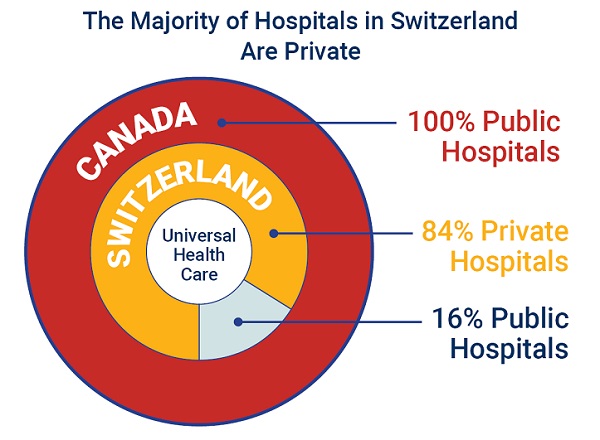Fraser Institute
Ottawa’s health-care deal cements failed status quo in Canada

From the Fraser Institute
By Mackenzie Moir and Jake Fuss
Canada will reach a projected $244.1 billion in 2023, which translates to $6,205 per person—nearly double the level of per-person spending (inflation-adjusted) three decades ago. And yet, last year Canadians endured the longest median wait time (27.7 weeks) ever recorded for non-emergency surgery.
Last week, as part of Ottawa’s promised $46 billion in additional health-care spending, the Trudeau government agreed to increase Quebec’s share of federal health-care dollars by $900 million annually. Quebec was the last province to reach an agreement with Ottawa before the March 31 deadline. With the closure of this agreement, Canadian taxpayers are on the hook for more health-care spending than ever before. For the same old broken health-care system.
Of course, it ultimately doesn’t matter whether the $46 billion originates from Ottawa or the provinces. In the end, Canadian taxpayers foot the bill. And what do we get in return for our health-care dollars?
In 2021, the latest year of comparable data, Canada’s total health-care spending (as a percentage of the economy) was the highest among 29 other comparable countries with universal health care (after adjusting for differences in population age). This isn’t a new development. Canada has a long history of having one of most expensive systems among high-income universal health-care countries.
Despite this, according to the latest comparable data, Canada ranks among the poorest performing universal health-care countries in key areas such as the number of physicians, hospital beds and diagnostic technology (e.g. MRI machines). Further, according to the Commonwealth Fund, in 2020 Canada ranked dead last on timely access to specialist consultations and non-emergency surgery.
Meanwhile, public health-care spending in Canada will reach a projected $244.1 billion in 2023, which translates to $6,205 per person—nearly double the level of per-person spending (inflation-adjusted) three decades ago. And yet, last year Canadians endured the longest median wait time (27.7 weeks) ever recorded for non-emergency surgery.
In short, Canada’s health-care system is in shambles, but the answer does not lie in simply throwing more money in its general direction. Federal politicians should instead look to the example of welfare reform during the Chrétien era in the 1990s. Those reforms, which reduced federal transfers to provinces and eliminated most of the “strings” attached to federal funding, resulted in increased provincial autonomy, greater policy experimentation, fewer Canadians needing welfare and savings for the federal government (i.e. taxpayers).
This is the opposite of today’s approach to health care, where the existing vehicle for federal funding (the Canada Health Transfer) is connected to the Canada Health Act (CHA), which prevents provincial governments from innovating and experimenting in health care by threatening financial penalties for non-compliance with often vaguely defined federal preferences. The result is a stalemate that satisfies no one and ensures that Canada’s policies remain at odds with the policies of our better-performing universal health-care peers.
While new federal dollars for health care are undoubtedly appealing to premiers, they will not improve the state of health care for Canadians. Until our federal politicians have the courage to reform the CHA and follow the example of 1990s welfare reform to improve outcomes, our health-care system’s unacceptable status quo will continue.
Authors:
Fraser Institute
Long waits for health care hit Canadians in their pocketbooks

From the Fraser Institute
Canadians continue to endure long wait times for health care. And while waiting for care can obviously be detrimental to your health and wellbeing, it can also hurt your pocketbook.
In 2024, the latest year of available data, the median wait—from referral by a family doctor to treatment by a specialist—was 30 weeks (including 15 weeks waiting for treatment after seeing a specialist). And last year, an estimated 1.5 million Canadians were waiting for care.
It’s no wonder Canadians are frustrated with the current state of health care.
Again, long waits for care adversely impact patients in many different ways including physical pain, psychological distress and worsened treatment outcomes as lengthy waits can make the treatment of some problems more difficult. There’s also a less-talked about consequence—the impact of health-care waits on the ability of patients to participate in day-to-day life, work and earn a living.
According to a recent study published by the Fraser Institute, wait times for non-emergency surgery cost Canadian patients $5.2 billion in lost wages in 2024. That’s about $3,300 for each of the 1.5 million patients waiting for care. Crucially, this estimate only considers time at work. After also accounting for free time outside of work, the cost increases to $15.9 billion or more than $10,200 per person.
Of course, some advocates of the health-care status quo argue that long waits for care remain a necessary trade-off to ensure all Canadians receive universal health-care coverage. But the experience of many high-income countries with universal health care shows the opposite.
Despite Canada ranking among the highest spenders (4th of 31 countries) on health care (as a percentage of its economy) among other developed countries with universal health care, we consistently rank among the bottom for the number of doctors, hospital beds, MRIs and CT scanners. Canada also has one of the worst records on access to timely health care.
So what do these other countries do differently than Canada? In short, they embrace the private sector as a partner in providing universal care.
Australia, for instance, spends less on health care (again, as a percentage of its economy) than Canada, yet the percentage of patients in Australia (33.1 per cent) who report waiting more than two months for non-emergency surgery was much higher in Canada (58.3 per cent). Unlike in Canada, Australian patients can choose to receive non-emergency surgery in either a private or public hospital. In 2021/22, 58.6 per cent of non-emergency surgeries in Australia were performed in private hospitals.
But we don’t need to look abroad for evidence that the private sector can help reduce wait times by delivering publicly-funded care. From 2010 to 2014, the Saskatchewan government, among other policies, contracted out publicly-funded surgeries to private clinics and lowered the province’s median wait time from one of the longest in the country (26.5 weeks in 2010) to one of the shortest (14.2 weeks in 2014). The initiative also reduced the average cost of procedures by 26 per cent.
Canadians are waiting longer than ever for health care, and the economic costs of these waits have never been higher. Until policymakers have the courage to enact genuine reform, based in part on more successful universal health-care systems, this status quo will continue to cost Canadian patients.
Business
84% of Swiss hospitals and 60% of hospitalizations are in private facilities, and they face much lower wait times

From the Fraser Institute
If Canada reformed to emulate Switzerland’s approach to universal health care, including its much greater use of private sector involvement, the country would deliver far better results to patients and reduce wait times, finds a new study published today by the Fraser Institute, an independent, non-partisan Canadian policy think-tank.
“The bane of Canadian health care is lack of access to timely care, so it’s critical to look to countries like Switzerland with more successful universal health care,” said Yanick Labrie, senior fellow at the Fraser Institute and author of Integrating Private Health Care Into Canada’s Public System: What We Can Learn from Switzerland. The study highlights how Switzerland successfully integrates the private sector into their universal health-care system, which consistently outperforms Canada on most health-care metrics, including wait times.
For example, in 2022, the percentage of patients who waited less than two months for a specialist appointment was 85.3 per cent in Switzerland compared to just 48.3 per cent in Canada.
In Switzerland, 84.2 per cent of all hospitals are private (either for-profit or not-for profit) institutions, and the country’s private hospitals provide 60.2 per cent of all hospitalizations, 60.9 per cent of all births, and 67.1 per cent of all operating rooms.
Crucially, Swiss patients can obtain treatment at the hospital of their choice, whether located inside or outside their geographic location, and hospitals cannot discriminate against patients, based on the care required.
“Switzerland shows that a universal health-care system can reconcile efficiency and equity–all while being more accessible and responsive to patients’ needs and preferences,” Labrie said.
“Based on the success of the Swiss model, provinces can make these reforms now and help improve Canadian health care.”

Integrating Private Health Care into Canada’s Public System: What We Can Learn from Switzerland
- Access to timely care remains the Achilles’ heel of Canada’s health systems. To reduce wait times, some provinces have partnered with private clinics for publicly funded surgeries—a strategy that has proven effective, but continues to spark debate in Canada.
- This study explores how Switzerland successfully integrates private health care into a universal public system and considers what Canada can learn from this model.
- In Switzerland, universal coverage is delivered through a system of managed competition among 44 non-profit private insurers, while decentralized governance allows each of the 26 cantons to coordinate and oversee hospital services in ways that reflect local needs and priorities.
- Nearly two-thirds of Swiss hospitals are for-profit institutions; they provide roughly half of all hospitalizations, births, and hospital beds across the country.
- All hospitals are treated equally—regardless of legal status—and funded through the same activity-based model, implemented nationwide in 2012.
- The reform led to a significant increase in the number of cases treated without a corresponding rise in expenditures per case, suggesting improved efficiency, better use of resources, and expanded access to hospital care.
- The average length of hospital stay steadily decreased over time and now stands at 4.87 days in for-profit hospitals versus 5.53 days in public ones, indicating faster patient turnover and more streamlined care pathways.
- Hospital-acquired infection rates are significantly lower in private hospitals (2.7%) than in public hospitals (6.2%), a key indicator of care quality.
- Case-mix severity is as high or higher in private hospitals, countering the notion that they only take on simpler or less risky cases.
- Patient satisfaction is slightly higher in private hospitals (4.28/5) than in public ones (4.17/5), reflecting strong user experience across multiple dimensions.
- Canada could benefit from regulated competition between public and private providers and activity-based funding, without breaching the Canada Health Act.










